- The settings and characters of your plays often reflect circumstances in the Chikuho region of Kyushu with its coalmining towns, like the one where you were born, and villages in the mountains where people live in isolation with the old regional customs and are often the subject of discrimination from the society at large.
-
Yes. My parents are both natives of the Chikuho region, and I grew up in a coalmining town where all the public facilities from the hospital to the local elementary school were owned by the coal mine company, so it couldn’t help but be an integral part of your life. I was only born there and lived there for less than a year before we moved away, but my maternal grandmother worked as a cook in a hospital that belonged to the local coal mine company, and since I spent a lot of time with my grandmother as a child, I listened to the many stories she told about the people that lived in a coalmining community and things like the terror of hearing the siren that sounded when there was an accident in the mine. Those were probably the strongest memories from my childhood. They come together in the plays of my “Coal Mine Trilogy,” and throughout my career as a playwright since I started my company I have been writing about these subjects.
The place my family moved when I was an infant was a small village in the mountains some distance away in Kasuya County. That was an environment where there has long been a belief in deities of the mountains and mountains that are considered sacred, and lodged between them there are also Buddhist temples, where the family graves are kept, and rows of Jizo (Buddhist patron guardian of children and travelers) statues. I lived there until I was ready to start elementary school and our family moved to the seaside town of Fukutsu-shi, which is known for its ancient [nobility] gravesites. The people of this town say that it is the origin of the tradition of ama, women pearl divers and shellfish gathers [a practice that spread throughout Japan], and it is the source I used for the play Umi no Megane (Sea Glasses [goggles]) that I wrote for the Bungakuza company. - This means that you use your own past experiences very directly as subject matter for your plays, does it?
- Well, yes. And, if there were another important influence from my younger years, it would probably be my mother, who was a middle school art teacher. In our house there were art encyclopedias and plaster busts of famous statues for sketching in art classes and lots of art reference books, and as a child I liked looking at them even before I knew what they were. Also, when my mother had to go to school on the weekends to work, I would go along and spend time alone in the art room, doing things like kneading clay. And, because the middle school that my mother worked at was in an district of Hakata that had a “ burakumin ” neighborhood (people of the former outcast caste of Japanese society), I naturally heard stories about them and the discrimination they suffered without even having to ask about it. In these ways, the person [artist] I am today was shaped to a large degree by the strong influences of my mother and grandmother.
- May we ask what kind of child you were?
- Looking at me today it might be hard to believe, but I was a very weak child who was in and out of the hospital all the time. Until about the third grade of elementary school I couldn’t even participate in physical education classes; I had to just watch from the sidelines. My parents wouldn’t even buy me a bicycle like the other kids because they thought it would be too dangerous for such a weak child. What’s more, since we lived in such a remote country village and I only had two little sisters, I had to play alone most of the time. Before I started going to school I spent most of my time reading books, or sitting under the porch of the temple and letting my imagination run wild, or sitting up in a tree thinking about whatever was on my mind, making up stories or drawing manga (comic book illustrations). I was a pretty dark, introverted child. (Laughs) I had very few opportunities to interact with people outside my own family and really knew little about the world beyond my small universe. So, there were really no people who might serve as models for my characters in my works. About the only ones I could use as models were the people of my family and products of my imagination.
- So, were you a withdrawn “stay-at-home” for much of your younger years?
- No. In the upper grades of elementary school I began playing basketball. They hadn’t let me participate in rigorous sports until then, but when I happened to try it in PE class one day; I surprised myself by being pretty good at it and found out for the first time that I had some athletic ability equal to the other kids. After that I really got into basketball and became more outgoing and cheerful in character. I went on to play on the basketball team in junior and senior high school. I even became captain of the team. The hard training we did on the team strengthened me, and thanks to that I was able to endure the hardships later when I became a theater company member.
- How did you get involved in theater?
-
It happened that my father liked cinema music, and when I was young he would take me along to see Chaplin films and movies like [Spielberg’s]
Jaws
. Once I find something I like, I seem to be the type that gets into 100%, and once I got into movies I was watching anything I could, without regard for genre. For a while I was seeing about 150 movies a year. So, after I graduated from high school and came to Tokyo, my aim was to become a screenplay writer. It was then that I discovered the experimental films of Shuji Terayama. Terayama had already passed away by that time but his plays were still being performed in a variety of forms, and it was watching those plays that changed my interest toward theater.
When I saw I play of Kunio Shimizu at the small theater Jan Jan in Shibuya I felt a strong resonance with something in me. When I saw a production of Shimizu-san’s play Tango, Fuyu no Owari ni (Tango at the End of Winter) directed by Yukio Ninagawa at the Parco Theater, I was so moved that I just sat there in the seat for a while after the play was over. In memory of the moment I picked up a piece of the paper snow used in the play and was the last one to leave the theater. The impact of that pay was what finally made me determined that I was going to create theater. - So, that is what made you decide to enter the Mokutousha company?
-
Yes. Actually, however, before that I worked for a year on a cattle farm in Hokkaido. Thinking about how poor I would be once I joined a theater company, without even enough money to see the movies that I loved so much, I got a bit depressed. And, since I had always wanted to work on a ranch, I decided to work there and after a year if I still wanted to do theater, then I would join a theater company. The ranch happened to be in a very remote part of the north where even the newspaper came only once every two or three days along with the mail, and there were northern foxes all around and even bears coming out every now and then. I got so homesick that I was on the verge of neurosis. During that time I had a friend sending me the monthly issues of theater magazines like
Shingeki
and
Theatro
and since I found that I still had the desire to do theater, I returned to Tokyo.
Fortunately, I was able to join the Mokutousha company as I had wanted, but I only stayed there for about two and a half years. I was still young and uncertain about what I really wanted to do, and since the company was run by Shimizu’s wife, the actress Noriko Matsumoto, most of the plays they did like Gakuya (Backstage) were for women. So, around the time that I began to feel it was different from the world of Shimizu-san’s theater I was interested in, I discovered Renji Ishibashi and Mako Midori’s company Gekidan Dainana Byodo and the Shinjuku Ryozanpaku company. Both companies performed plays in spaces outside the theater or in tents, and I was drawn strongly to that dynamic world they created. At the time, I felt a link between the lyrical plays that Chong Wishing was writing at Ryozanpaku and the plays of Shimizu, so I asked to join Shinjuku Ryozanpaku and they accepted me. - At the time did you want to write and direct?
- No. When I entered the company I still didn’t have a clear idea of what I wanted to do, and that didn’t change for the nine years I was with the company. Most of my time was spent working on sets and sound work. At the end I was also acting in the company’s plays, but rather than it being a matter of capability, it seemed to be more a case of it being my turn in the rotation. The most important thing I gained from being at Ryozanpaku was the opportunity to work at close quarters with the writer Chong Wishing. Wishing-san is not only a great playwright but also someone I admire very much as a person. All of the actors at Ryozanpaku and their leader Kim Sujin have strong individual characters and plenty of depth and attitude that were very stimulating for me.
- After that, in 1999 you formed the company Gekidan Sajiki Douji with a maiden performance of the play Gakidou no Toshi .
- At one point I felt that it would be meaningless to go on as I was and the time had come for me to take assessment and decide where I was going. Then I found out that a number of people in the company were thinking the same ways as me, so we decided that we had nothing to lose by leaving Ryozanpaku and trying to do theater of our own that we really wanted to do. The result was that nine of us got together to form Gekidan Sajiki Douji. The nine were Yuji Ihara, who had already quit the company and moved to the company Karagumi and his fellow members Judai Ikeshita, Momoko Itagaki and Yoshitaka Inaba, and then me and two others who quit Ryozanpaku, Megumi Suzuki and Hiromi Toyama, and also Kentaro Haraguchi, who I knew from Mokutousha. You could call us a group of dropouts from these companies. (Laughs) I was in my mid-30s and the youngest were in their 20s, so in terms of age we spanned about a dozen years. But, we all had the same desire to do our best to create theater that we could put our hearts in.
- In your Sajiki Douji company productions you use the fictitious names Sajikidouji for the playwright and Chiriakuta for the stage artist. Is this because you want to show that yours are group productions?
-
When we started the company, I had some desire to write plays, but I was even more drawn to the prospect of doing stage art. We looked for a writer but couldn’t find one, so all of the company members talked together about ideas for a play. I put those ideas together and wrote about the first third of a scenario, and when I showed it to everyone, they said, “OK, let’s do it.” But, still, I thought it would be impossible for me to write the whole thing by myself, so I used the fictitious name Sajikidouji to signify that it would be a joint creation by the members. That first play was
Gakidou no Toshi
(City of the hungry spirit [devil]) based on a legend about a water deity from The Fukuoka region.
In the same way, Chiriakuta symbolizes that, although I usually make the initial plan, the stage art and set are made as a joint effort of all the members of the company. With regard to the playwriting, although Ihara has worked on a few scripts, basically I have done most of them alone. The reason that I continue to use Sajikidouji is to remind myself never to forget the original purpose we started with.
By the way, the company name Sajiki Douji is a play on the name of a guardian deity from ancient Japanese myth, Zashikiwarashi, [whose name uses the same Chinese characters except for the first one]. Zashikiwarashi can’t be seen, but when it abides in a house, that house [and its business] always flourishes. This name we chose to symbolize our humble wish that if people don’t see anything in our plays, they don’t need to come to them, but there are still some people who like them. (Laughs) - Your scripts are basically written in the Hakata dialect of the Fukuoka area of Kyushu, aren’t they?
- Yes. But, we don’t adhere strictly to an authentic Hakata (Fukuoka) or Chikuho dialect or accent. It is actually a mixture of dialects that you might call Kyushu dialect. I tell the company members that they don’t have to worry about the exact intonation of the dialect, as long as they deliver the feeling for the accent. (Laughs) The main reason I use the dialect is simply that it is the most familiar to me. You could call it my mother tongue, and it simply makes my writing flow more easily. Another thing is that most theater in Tokyo uses the standard Japanese national dialect [ hyojungo ], so using the Kyushu dialect is effective in differentiating us from the other companies around. It also has good nuance and can be delivered with better rhythm and is essential for me in giving a sense of the lifestyle and living conditions of my characters.
- Could you tell us about your actual writing process?
-
It’s a rather rough working style. Once I get a basic theme, I don’t do a block scenario or anything; I just start writing what comes to mind. I just start writing instinctively, but by the time it reached about ten pages, I can usually begin to see the structure of the entire storyline. When I think I am about one-third of the way into the story I will begin writing down items on the side about things I envision happening along the way and how the end will conclude. Then I use those as guides to proceed and write it out to the end.
I can’t write if I don’t have an image in my mind of the actors that will play the roles. When I write a scenario for another company or such outside of our own company, I have them give me photographs of the actors who will be playing the parts so I can look at their faces as I write. On the other hand, in the case of our own company, I have been working with them for a dozen years now, so I have to make an effort to keep each actor’s roles from falling into the same patterns. To do that, I have to eliminate their faces from my mind as I write and in their place I imagine a star I liked from the silver screen. I will say to myself, for example, that this role is for Toshiro Mifune, or this role is for Nobuko Otowa. In that way I create my own imaginary cast for all the characters. The casting can be pretty amazing (laughs), but I feel it is important for me to do this to avoid narrowing the possibilities for the actors.
I do a considerable amount of research as well for the subject I choose. When I go back to Fukuoka there is a lot of material in archives about the region’s old temples and shrines and the local history. I discover a lot of things recorded in those sources about the historical events and customs that is fascinating to me. For those of us in the so-called “buddle generation” [who came of age during Japan’s buddle economy of the 1980s] who didn’t experience World War II or the anti-establishment riots protesting the defense treaty with the U.S. at the end of the 1960s, and were too late for the passionate years of the underground ( angura ) theater movement, we never had a mission of those types. For someone of that generation like myself, the local history of my home area provides a wealth of material for my writing. The local folklore and customs are rich in human wisdom and human sorrow, and my play writing is a process of finding and bringing out those elements to be played out on a large scale. Lately my schedule doesn’t allow me much time for such travel, but in the past I used to go to actual sites of the legends and events and customs so I could breathe the air of those places and get a tangible feeling for them. - One of the unique qualities of your Sajiki Douji productions is the large-scale and intricately constructed stage art. How is the stage art planned?
-
At first there was a desire to make sets that were very elaborate. Some of the sets are constructed so that they are movable and can undergo massive changes at the end of the play to change the scenery, but when there are going to be many movements and transformations of the set, it is difficult to decorate it fully. So, what we do is to decorate the parts elaborately to create different types of spaces within it.
The motifs for the spaces are the same as with the subject matter of the plays; they are scenes from memories of things that I have heard about or seen in the past. I like stage art that is intricate and elaborate to excess, such as filling spaces in the sets with large numbers of flowers and constructing things like windmills. But, we also have small-scale performances on a regular basis that we call “extra performances” and for those the stage art may be no more than a 4-mat tatami room or a set that is virtually a bare stage. - It must take a lot of work to create such elaborate stage art for your main productions, however.
-
With the whole company working together full-time it will take from a week to even three weeks, and during that period we are all working hard and are so tired that we can’t rehearse. It is only after the stage art is finished that we begin full and detailed rehearsals using the finished set. The reason we are able to create such elaborate sets is that we are not performing in regular theaters, but in places like warehouses. Unlike theaters, these spaces have their own unique spatial and location-specific qualities of the building, just like outdoor venues or tent productions, and that is an essential element for the type of stages and plays I want to create. However, finding such locations was always difficult, but now the Suzuki Kosan company leases us its warehouse in the Kinshi-cho district of Tokyo, which is a big help for us.
By any measure, creating stage art this elaborate requires a lot of strength, both physically and mentally. But, creating stage art that is both highly sophisticated in design and elaborate in execution is a symbol, in my mind, of true professionalism in theater, so I want us to do our best in that area. However, as we get older we will eventually have to give up on doing all ourselves, and when that time comes, I will probably be forced to make a choice between either changing my style and doing plays for bare stages like Kohei Tsuka does, or else I will have to disband the company. - Lately, we see an increasing number of places doing productions that are planned and organized by producers, and there are few companies like yours that continue to pursue a group production type of theater. I believe that, because of the overall atmosphere of your style of production with stage art built into warehouse-type spaces, you are usually categorized as an underground [ angura ] company. However, rather than the acting based on almost superhuman or demonic performances by actors with dominating physical presence that typified angura theater, I feel that your company’s style is much more focused on an acting style that accentuates the strengths of an integrated ensemble.
-
In terms of my age, I am of the same age as Tatsuo Kaneshita and have the same type of concern for collective efforts, but since I was late to form a company, in terms of our company’s career we are about the same as
Go Aoki
’s company Gringu.
It is true that people often say, “You’re and angura company, aren’t you?” And, simply because it is a bother trying to explain the difference, I don’t try to deny it. However, in terms of our acting we are not angura , and we have no desire to carry on the angura tradition. In the company Ryozanpaku I was formerly with, there were angura -rooted actors like Naomasa Musaka-san of the so-called kaiyu (an actor with a strong and often eccentric character and acting style) that typified the genre, but in our company there are no such actors of exceptional individuality or presence. The theater world we create at Sajiki Douji is one created by a group of “dropouts” with no such actor-heroes. So, when we ask people from outside the company to work with us on performances, we try to seek out people who can act in a natural, unimposing way. That is not only the acting style that I prefer, it is also a style rooted in the great performances of the “ Shingeki ” (New Theater) era plays that my mother used to take me to see. I remember the performance of actors and actresses of that time like Hideji Otaki and Haruko Sugimura that left a strong impression on me even as a child. - Recently you have increasing opportunities to write plays and scenarios for productions other than your own company. Also, in 2012 you received a number of prestigious drama awards. Would you tell us about your aspirations for the future?
- That may be true, but in fact the constant output of these past one or two years has left me feeling quite empty. There is a lot of theater that I want to do, but I easily reach an impasse where I can’t move forward. I guess I am weak of will. When I reach an impasse I may make an excuse that I am searching for material and go see about ten movies in succession, or I may go to see plays that I like, despite my preoccupied state. I’m beyond help (laughs). But, despite all the ups and downs, I believe I am going to continue creating theater. Despite the difficulties, I am sure that the support I get from our company members will keep me writing and directing. I have to believe that I can continue to do what I do as best I can ad that it will continue to produce the kind of theater that I want to see.
Kenji Higashi
Kenji Higashi and his plays driven by group performance and the power of fantasy
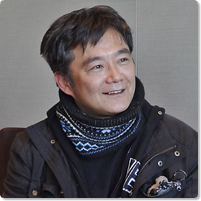
Kenji Higashi
Playwright and director. Born 1964 in Fukuoka Prefecture. In 1999, he formed the theater company Gekidan Sajiki Douji and served as its representative. Many of his plays are set in coalmining towns like Chikuho in Fukuoka where he was born. His plays using dynamic movable sets and the power of group performances have won high acclaim. One of his representative works is the trilogy of coal mine plays Dorobana (2006, Mud Flower), Obake no Taiyo (2011, Ghost’s Sun) and Oyogu Kikansha (The Swimming Locomotive). Higashi was shortlisted for the Kishida Drama Award three years running with Shanshan kageboshi (Living Shadows) in 2004, Furaibo raijin yashiki (The Vagabond Thunder God Mansion) in 2005, and Umineko gai (Umineko Town) in 2006. His play Umineko gai won the Award of Excellence of the 2005 National Arts Festival of the Agency for Cultural Affairs (Kanto Division). Higashi won the individual artist award of the 47th Kinokuniya Theater Prize for the Bungakuza Atelier production of the play Umi no Megane (Sea Glasses) and the Gekidan Sajiki Douji production of the play Oyogu Kikansha and its directing, he won the 20th Yomiuri Theater Awards Best Director Prize for the Tom Project production of Mangetsu no Hito yo (You people of the full moon) and Oyogu Kikansha . Oyogu Kikansha was also the winner of the 16th Tsuruya Namboku Memorial Drama Award.
Gekidan Sajiki Douji
https://www.sajikidouji.com/
Interviewer: Kumiko Ohori

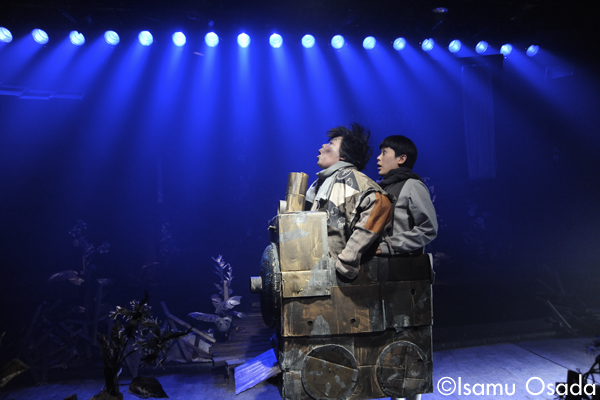
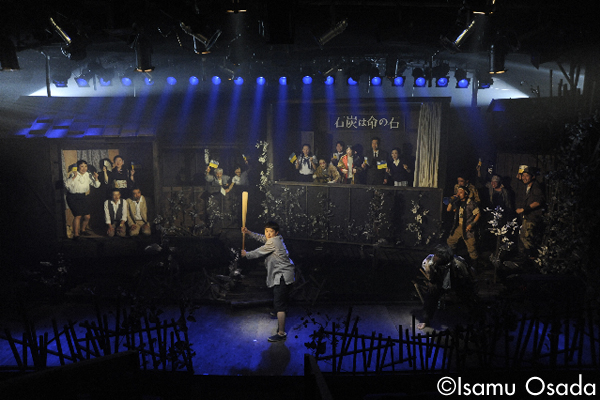
Oyogu Kikansha
(Dec. 13 – 25, 2012 at Sumida Park Studio “kura”)
Photo: Isamu Osada

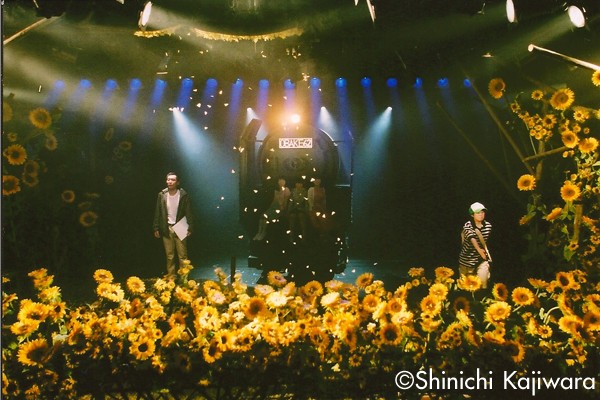
Obake no Taiyo
(Ghost’s Sun)
(Jun. 15 – 26, 2011 at Sumida Park Studio “kura”)
Photo: Shinichi Kajiwara
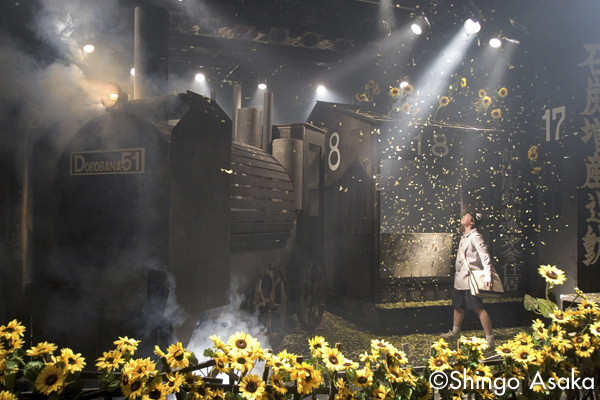
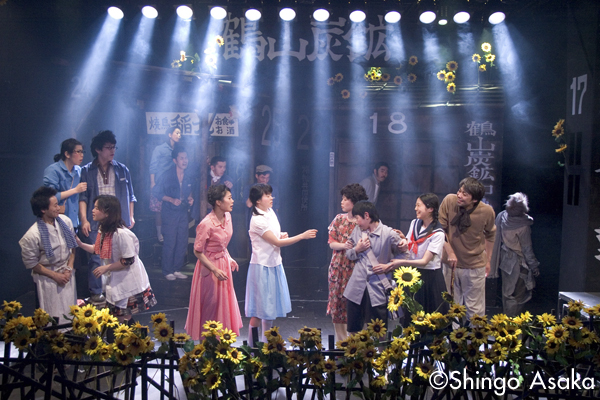
Dorobana
(Mud Flower)
(Feb. 10 – 19, 2006 at Shimokitazawa The Suzunari)
Photo: Shingo Asaka
Related Tags

